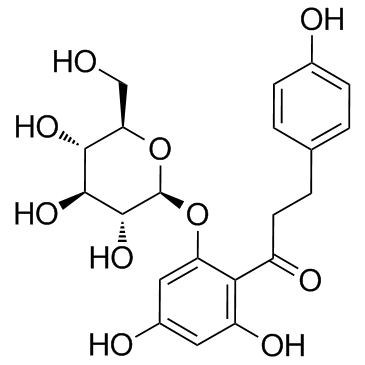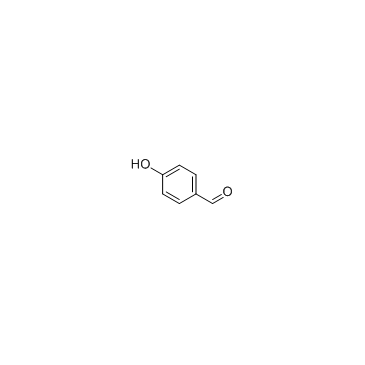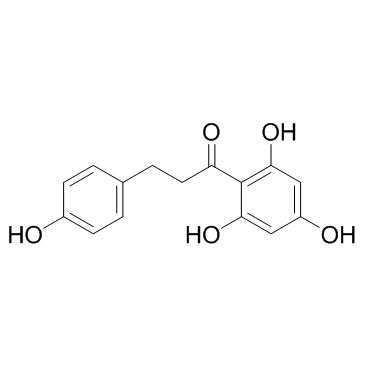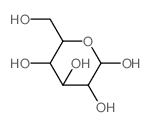60-81-1
| Name | phlorizin |
|---|---|
| Synonyms |
phlorizoside
4,6-dihydroxy-2-(β-D-glucosido)-β-(p-hydroxyphenyl)propiophenone 3,5-Dihydroxy-2-[3-(4-hydroxyphenyl)propanoyl]phenyl-β-D-glucopyranoside 1-(2,4-Dihydroxy-6-{[(2S,3R,4S,5S,6R)-3,4,5-trihydroxy-6-(hydroxymethyl)tetrahydro-2H-pyran-2-yl]oxy}phenyl)-3-(4-hydroxyphenyl)-1-propanone phloridzosid phloridzine Phlorrhizen phloretin 2'-O-glucoside 1-Propanone, 1-[2-(β-D-glucopyranosyloxy)-4,6-dihydroxyphenyl]-3-(4-hydroxyphenyl)- Phlorizin Isosalipurposide Phloretin-2'-b-glucoside Phloridzin Phlorhizin 3,5-Dihydroxy-2-[3-(4-hydroxyphenyl)propanoyl]phenyl β-D-glucopyranoside 1-(2,4-Dihydroxy-6-{[(2S,3R,4S,5S,6R)-3,4,5-trihydroxy-6-(hydroxyméthyl)tétrahydro-2H-pyran-2-yl]oxy}phényl)-3-(4-hydroxyphényl)-1-propanone 1-[2-(β-D-Glucopyranosyloxy)-4,6-dihydroxyphenyl]-3-(4-hydroxyphenyl)-1-propanone 1-(2,4-Dihydroxy-6-{[(2S,3R,4S,5S,6R)-3,4,5-trihydroxy-6-(hydroxymethyl)tetrahydro-2H-pyran-2-yl]oxy}phenyl)-3-(4-hydroxyphenyl)-1-propanon 2'-(β-D-glucopyranosyloxy)-4',6'-dihydroxy-3-(4-hydroxyphenyl)propiophenone 4,6-Dihydroxy-2-(b-D-glucosido)-b-(p-hydroxyphenyl)propiophenone Phloretin-2'-O-glucoside Floridzin MFCD00006591 1-[2-(b-D-Glucopyranosyloxy)-4,6-dihydroxyphenyl]-3-(4-hydroxyphenyl)-1-propanone 1-Propanone, 1-(2-(β-D-glucopyranosyloxy)-4,6-dihydroxyphenyl)-3-(4-hydroxyphenyl)- Phloretin-2'-β-glucoside phlorrhizin EINECS 200-487-1 |
| Description | Phlorizin is a non-selective SGLT inhibitor with Kis of 300 and 39 nM for hSGLT1 and hSGLT2, respectively. Phlorizin is also a Na+/K+-ATPase inhibitor. |
|---|---|
| Related Catalog | |
| Target |
Ki: 300 nM (hSGLT1), 39 nM (hSGLT2)[1] Na+/K+-ATPase[2] |
| In Vitro | Phlorizin is a non-selective SGLT inhibitor with Kis of 300 and 39 nM for hSGLT1 and hSGLT2, respectively[1]. Phlorizin is also a Na+/K+-ATPase inhibitor[2]. Phlorizin at 2×10-4 M inhibits Na+ and Rb+-activated ATPase activities in human red cell membranes by 43 %. At 1 mM and 7 mM RbCl, rubidium uptake is not changed or is slightly inhibited (less than 15 %) by 2×10-4 M Phlorizin[2]. Cell viability is not significantly altered by doses of Phlorizin <100 μM. Pretreating cells with Phlorizin does not significantly reduce nitrite or PGE2 levels. Phlorizin does not suppress IL-6 or TNF-α production, although 100 μM Phlorizin can significantly inhibit TNF-α expression[3]. |
| In Vivo | Prior to Phlorizin treatment, the blood glucose level in SDT fatty rats is 370±49 mg/dL. Six hours after dosing, the blood glucose level in the Phlorizin treated group decreases to an almost normal level (139±32 mg/dL). Phlorizin-treated SDT fatty rats are heavier than vehicle-treated SDT fatty rats after 12 weeks. Phlorizin treatment significantly decreases glucose excretion and delays insulin decreases. Creatinine clearance decreases significantly with Phlorizin treatment. 23 weeks of Phlorizin treatment prevents the decrease of nerve fibers (23.6±3.2 fibers/mm). Retinal abnormalities are completely prevented with Phlorizin[4]. |
| Kinase Assay | Resealed ghosts are obtained with the addition of 4×10-3 M ATP and 5×10-3 M MgCl2 with or without 5×10-4 M Phlorizin (final concentration) when red cells are hemolyzed. Ghosts corresponding to 0.4-0.45 mL of the original blood cells are incubated with 0.9 mL of Medium A and 86RbCl for 45 or 90 min and the radioactivity in 200 μL of the supernatant is determined. The ATPase activity in the resealed ghosts is determined from the increase in inorganic phosphate after incubation[1]. |
| Cell Assay | The RAW264.7 murine macrophage-derived cell line is used. Cell viability is measured using the 3-(4,5-Dimethylthiazol-2-yl)-2,5-diphenyltetrazolium bromide (MTT) assay. Cells (105 cells/well) are cultured in 96-well plates and treated with varying concentrations of Phlorizin for 24 h. Next, the supernatant is removed and the cells are incubated with MTT (50 mg/mL) for 4 h at 37°C. The plates are washed and isopropanol is added to dissolve formazone crystals, then the absorbance values are measured at 570 nm using a microplate reader[3]. |
| Animal Admin | Female SDT fatty rats are used in this study. At six weeks of age, SDT fatty rats are divided into two groups (n=8); a Phlorizin treated group and a vehicle treated group. Age-matched female Sprague-Dawley (SD) rats are used as control animals (n=8). Animals are housed in a climate-controlled room (temperature 23±3°C, humidity 55±15%, 12 h lighting cycle) and allowed free access to basal diet and water. Phlorizin is injected subcutaneously once daily (100 mg/kg/day) to animals in the Phlorizin treated group for 23 weeks. Twenty % propylene glycol is administered to animals in the vehicle treated group and control SD rats[4]. |
| References |
| Density | 1.6±0.1 g/cm3 |
|---|---|
| Boiling Point | 770.0±60.0 °C at 760 mmHg |
| Melting Point | 113-114 °C(lit.) |
| Molecular Formula | C21H24O10 |
| Molecular Weight | 436.409 |
| Flash Point | 270.7±26.4 °C |
| Exact Mass | 436.136932 |
| PSA | 177.14000 |
| LogP | 0.45 |
| Vapour Pressure | 0.0±2.8 mmHg at 25°C |
| Index of Refraction | 1.686 |
| Storage condition | 2-8°C |
|
Section I.Chemical Product and Company Identification Chemical Name Phlorizin Portland OR SynonymPhloridzin Chemical FormulaC21H24O10•2H2O CAS Number60-81-1 Section II.Composition and Information on Ingredients Chemical NameCAS Number Percent (%)TLV/PELToxicology Data Phlorizin60-81-1Min. 97.0 (T) Not available.Mouse LD (intraperitoneal) >500mg/kg Section III. Hazards Identification Acute Health EffectsIrritating to eyes and skin on contact. Inhalation causes irritation of the lungs and respiratory system. Inflammation of the eye is characterized by redness, watering, and itching. Skin inflammation is characterized by itching, scaling, reddening, or, occasionally, blistering. Follow safe industrial hygiene practices and always wear proper protective equipment when handling this compound. Chronic Health EffectsCARCINOGENIC EFFECTS : Not available. MUTAGENIC EFFECTS : Not available. TERATOGENIC EFFECTS : Not available. DEVELOPMENTAL TOXICITY: Reproductive: rat (intraperitoneal) 600mg/kg. Duration: female 8 days of pregnancy. Effects on fertility- Post-implantation mortality. There is no known effect from chronic exposure to this product. Repeated or prolonged exposure to this compound is not known to aggravate existing medical conditions. Section IV.First Aid Measures Eye ContactCheck for and remove any contact lenses. IMMEDIATELY flush eyes with runing water for at least 15 minutes. keeping eyelids open. COLD water may be used. DO NOT use an eye oitment. Flush eyes with running water for a minimum of 15 minutes, occasionally lifting the upper eyelids. Seek medical attention. Treat symptomatically and supportively. Skin ContactAfter contact with skin, wash immediately with plenty of water. Gently and thorough wash the contaminated skin with running water and non-abrasive soap. Be particularly careful to clean folds, crevices, creases and groin. COLD water may be used. Cover the irritated skin with an emollient. Seek medical attention. Treat symptomatically and supportively. Wash any contaminated clothing before reusing. InhalationIf the victim is not breathing, perform artificial respiration. Loosen tight clothing such as a collar, tie, belt or waistband. If breathing is difficult, oxygen can be administered. Seek medical attention. Treat symptomatically and supportively. IngestionINDUCE VOMITING by sticking finger in throat. Lower the head so that the vomit will not reenter the mouth and throat. Loosen tight clothing such as a collar, tie, belt, or waistband. If the victim is not breathing, administer artificial respiration. Examine the lips and mouth to ascertain whether the tissues are damaged, a possible indication that the toxic material was ingested; the absence of such signs, however, is not conclusive. Seek immediate medical attention and, if possible, show the chemical label. Treat symptomatically and supportively. Section V.Fire and Explosion Data Auto-IgnitionNot available. FlammabilityMay be combustible at high temperature. Flash PointsFlammable LimitsNot available. Not available. Combustion Products These products are toxic carbon oxides (CO, CO 2). Fire Hazards No specific information is available regarding the flammability of this compound in the presence of various materials. Risks of explosion of the product in presence of mechanical impact: Not available. Explosion Hazards Risks of explosion of the product in presence of static discharge: Not available. No additional information is available regarding the risks of explosion. Fire Fighting Media SMALL FIRE: Use DRY chemicals, CO 2, water spray or foam. LARGE FIRE: Use water spray, fog or foam. DO NOT use water jet. and Instructions Continued on Next Page Phlorizin Section VI.Accidental Release Measures Spill CleanupIrritating material. InstructionsIn case of a spill and/or a leak, always shut off any sources of ignition, ventilate the area, and exercise caution. Use a shovel to put the material into a convenient waste disposal container. Finish cleaning the spill by rinsing any contaminated surfaces with copious amounts of water. Consult federal, state, and/or local authorities for assistance on disposal. Section VII. Handling and Storage IRRITANT. Keep away from heat and sources of ignition. Mechanical exhaust required. When not in use, tightly seal the Handling and Storage container and store in a dry, cool place. Avoid excessive heat and light. DO NOT breathe dust. Information Always store away from incompatible compounds such as oxidizing agents. Section VIII. Exposure Controls/Personal Protection Engineering ControlsUse process enclosures, local exhaust ventilation, or other engineering controls to keep airborne levels below recommended exposure limits. If user operations generate dust, fume or mist, use ventilation to keep exposure to airborne contaminants below the exposure limit. Personal ProtectionSplash goggles. Lab coat. Dust respirator. Boots. Gloves. Be sure to use a MSHA/NIOSH approved respirator or equivalent. Suggested protective clothing might not be sufficient; consult a specialist BEFORE handling this product. Exposure LimitsNot available. Section IX. Physical and Chemical Properties Solubility Physical state @ 20°CYellow powder.1g dissolves in water @ 22°C, 64mL water @ 60°C, 22mL water @ 70°C. Not available.Freely soluble in boiling water, in about 4 Specific Gravity parts alcohol, methanol, amyl alcohol, acetone, ethyl acetate, pyridine, aniline. Practically insoluble in ether, chloroform and benzene. Molecular WeightPartition Coefficient 436.41 (Anh)Not available. Boiling PointVapor Pressure Not available.Not available. Melting Point110°C (230°F)Vapor DensityNot available. Refractive IndexNot available.VolatilityNot available. Critical TemperatureNot available.OdorNot available. ViscosityNot available.TasteSweet with biter aftertaste. Section X.Stability and Reactivity Data Stability This material is stable if stored under proper conditions. (See Section VII for instructions) Conditions of InstabilityAvoid excessive heat and light. Incompatibilities Reactive with strong oxidizing agents. Section XI. Toxicological Information RTECS NumberUC2080000 Eye contact. Ingestion. Inhalation. Skin contact. Routes of Exposure Toxicity DataMouse LD (intraperitoneal) >500mg/kg Chronic Toxic EffectsCARCINOGENIC EFFECTS : Not available. MUTAGENIC EFFECTS : Not available. TERATOGENIC EFFECTS : Not available. DEVELOPMENTAL TOXICITY: Reproductive: rat (intraperitoneal) 600mg/kg. Duration: female 8 days of pregnancy. Effects on fertility- Post-implantation mortality. There is no known effect from chronic exposure to this product. Repeated or prolonged exposure to this compound is not known to aggravate existing medical conditions. Acute Toxic EffectsIrritating to eyes and skin on contact. Inhalation causes irritation of the lungs and respiratory system. Inflammation of the eye is characterized by redness, watering, and itching. Skin inflammation is characterized by itching, scaling, reddening, or, occasionally, blistering. Follow safe industrial hygiene practices and always wear proper protective equipment when handling this compound. Continued on Next Page Phlorizin Section XII.Ecological Information EcotoxicityNot available. Not available. Environmental Fate Section XIII. Disposal Considerations Recycle to process, if possible. Consult your local or regional authorities. You may be able to dissolve or mix material with Waste Disposal a combustible solvent and burn in a chemical incinerator equipped with an afterburner and scrubber system. Observe all federal, state, and local regulations when disposing of the substance. Section XIV. Transport Information DOT ClassificationNot a DOT controlled material (United States). Not applicable. PIN Number Proper Shipping Name Not applicable. Packing Group (PG)Not applicable. DOT Pictograms Section XV. Other Regulatory Information and Pictograms TSCA Chemical InventoryThis product is NOT on the EPA Toxic Substances Control Act (TSCA) inventory. The following notices are required by 40 CFR 720.36 (C) for those products not on the inventory list: (EPA) (i) These products are supplied solely for use in research and development by or under the supervision of a technically qualified individual as defined in 40 CFR 720.0 et sec. (ii) The health risks of these products have not been fully determined. Any information that is or becomes available will be supplied on an MSDS sheet. WHMIS ClassificationNot available. (Canada) EINECS Number (EEC) 200-487-1 EEC Risk StatementsR36/37/38- Irritating to eyes, respiratory system and skin. SECTION 16 - ADDITIONAL INFORMATION N/A |
CHEMICAL IDENTIFICATION
HEALTH HAZARD DATAACUTE TOXICITY DATA
|
| Hazard Codes | Xi: Irritant; |
|---|---|
| Risk Phrases | R36/37/38 |
| Safety Phrases | S26-S36 |
| WGK Germany | 3 |
| RTECS | UC2080000 |
|
~% 
60-81-1 |
| Literature: Chemische Berichte, , vol. 75, p. 1040,1041 |
|
~% 
60-81-1 |
| Literature: Chemische Berichte, , vol. 76, p. 386,388, |
|
~% 
60-81-1 |
| Literature: Chemische Berichte, , vol. 75, p. 1040,1041 |





